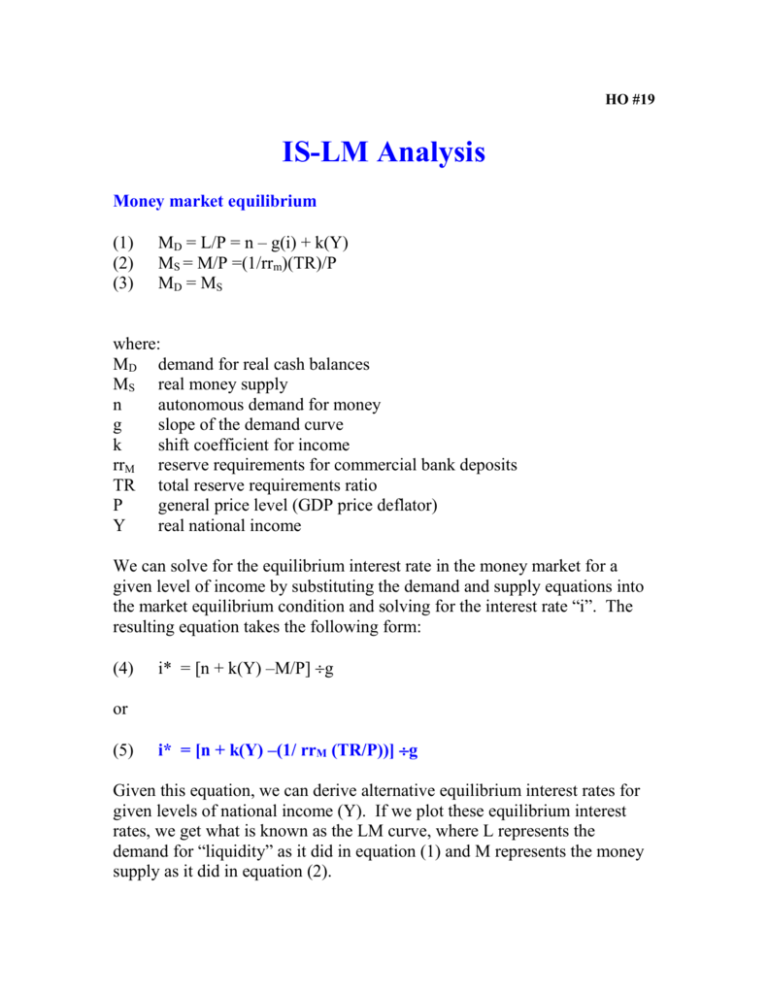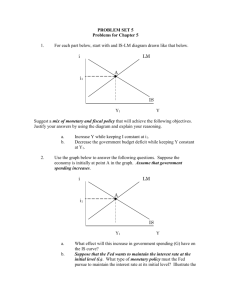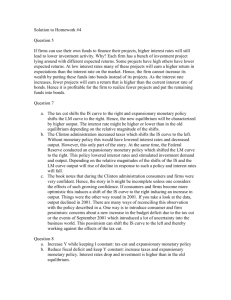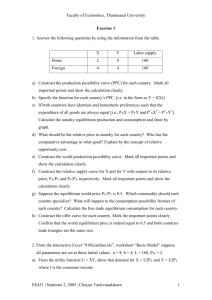Money market equilibrium
advertisement

HO #19 IS-LM Analysis Money market equilibrium (1) (2) (3) MD = L/P = n – g(i) + k(Y) MS = M/P =(1/rrm)(TR)/P MD = MS where: MD demand for real cash balances MS real money supply n autonomous demand for money g slope of the demand curve k shift coefficient for income rrM reserve requirements for commercial bank deposits TR total reserve requirements ratio P general price level (GDP price deflator) Y real national income We can solve for the equilibrium interest rate in the money market for a given level of income by substituting the demand and supply equations into the market equilibrium condition and solving for the interest rate “i”. The resulting equation takes the following form: (4) i* = [n + k(Y) –M/P] g or (5) i* = [n + k(Y) –(1/ rrM (TR/P))] g Given this equation, we can derive alternative equilibrium interest rates for given levels of national income (Y). If we plot these equilibrium interest rates, we get what is known as the LM curve, where L represents the demand for “liquidity” as it did in equation (1) and M represents the money supply as it did in equation (2). LM i3 i2 i1 Y1 Y2 Y3 Each and every point along the LM curve depicted above represents an equilibrium in the money market. Product market equilibrium (6) (7) (8) (9) (10) C = a + b(Y – T) I = j – f(i) G = G* Y=C+I+G T = h + t(Y) where: C Planned real consumption expenditures a Autonomous consumption b Marginal propensity to consume Y Real national income and product T Real government revenue I Real planned investment expenditures j G h t Autonomous investment Real government expenditures (* denotes fixed spending) Tax base Marginal tax rate We can solve for the equilibrium level of product or output in the product market for a given interest rate by substituting the consumption, investment and government expenditures equations into equation (9) and solve for the corresponding level of gross domestic product (Y). The resulting equation takes the following form: (11) Y* = a + b(Y – T) + j – f(i) + G* Substituting in the equation for tax revenue (T) into equation (11) and isolating Y on the left-hand side, we see that: (12) Y* = [a – b(h) + j + G*]/(1 – b +b(t)) - [f/ (1 – b +b(t))] i Given this equation, we can derive alternative equilibrium gross domestic product for given levels of interest rates (i). If we plot these equilibrium gross domestic product levels, we get what is known as the IS curve, where I represents the demand for investment expenditures as it did in equation (7) and S represents the level of savings in the economy, or: (13) S=Y–T–C IS i3 i2 i1 Y3 Y2 Y1 Each and every point along the IS curve depicted above represents an equilibrium in the product market. General equilibrium We now have two partial equilibriums; one in the money market for given levels of income and one in the product market for given levels of interest rates. We can determine the general equilibrium in both markets by determining where these two curves intersect, or: IS LM iE YE This graph suggests that only one interest rate and one level of gross domestic product satisfies the equilibrium conditions in both markets simultaneously. Policy Actions How does monetary and fiscal policy affect the IS and LM curves? Expansionary (contractionary) monetary policy will shift the LM curve to the right (left) while expansionary (contractionary) fiscal policy will shift the IS curve to the right (left). Make sure you are comfortable with the implications these changes in policy will have upon the directional changes for interest rates and gross domestic product. Monetary policy actions shift the LM curve and leave the IS curve alone. Expansionary monetary policy will shift the LM curve to the right, lowering interest rates and stimulating aggregate demand through investment, jobs and consumption. Contractionary monetary policy will have exactly the opposite effects. IS LM LM* Expansionary Monetary policy i Y IS IS* LM i Expansionary Fiscal policy Y Fiscal policy actions shift the IS curve and leave the LM curve alone. Expansionary fiscal policy will shift the IS curve to the right, stimulating aggregate demand through increased after tax income and government spending, but increasing interest rates. Contractionary fiscal policy will have exactly the opposite effects. General price level We can determine the general equilibrium price level in the economy (PE) by associating the general equilibrium conditions in the last graph with a graph of the equilibrium in the product market as follows: IS LM iE YE AD PE AS








